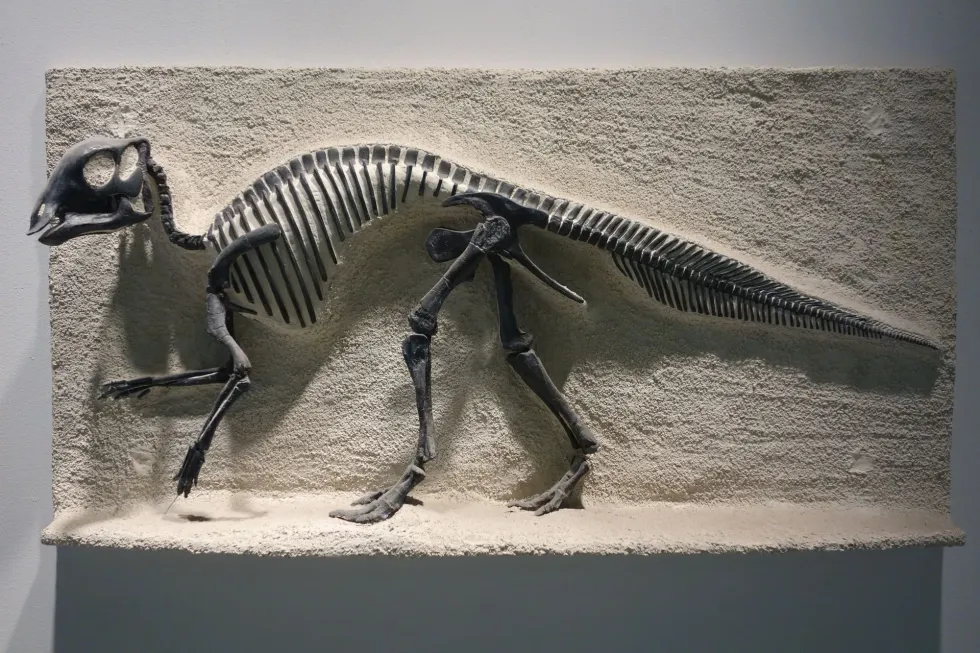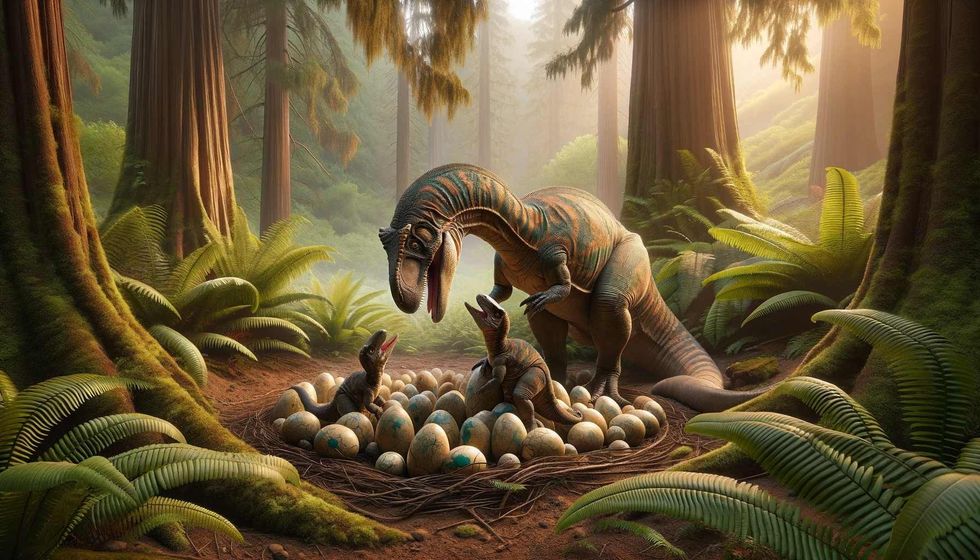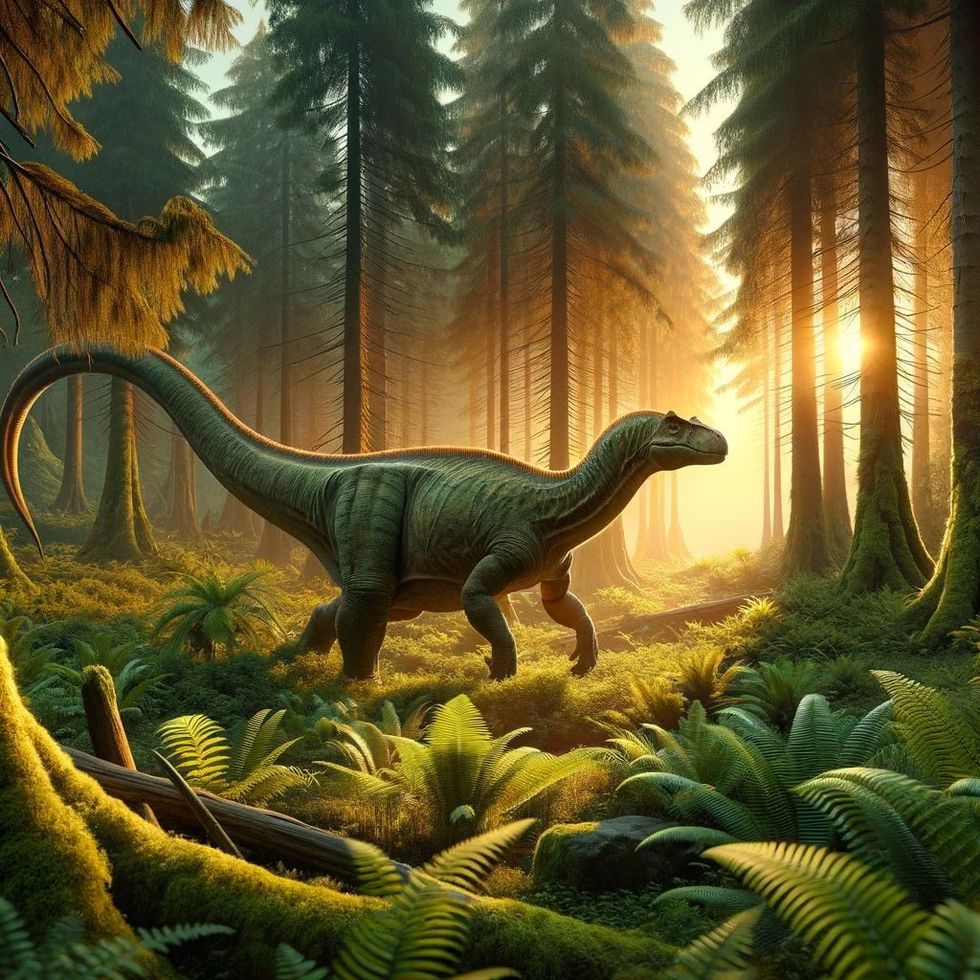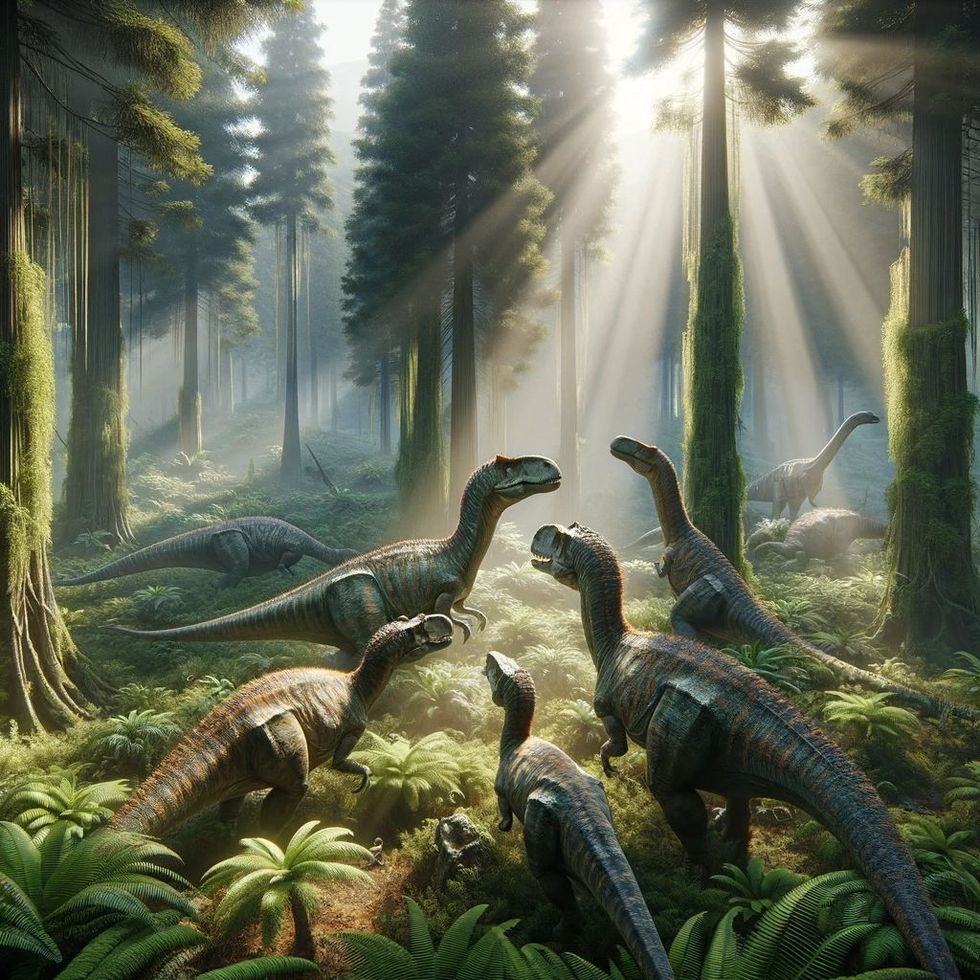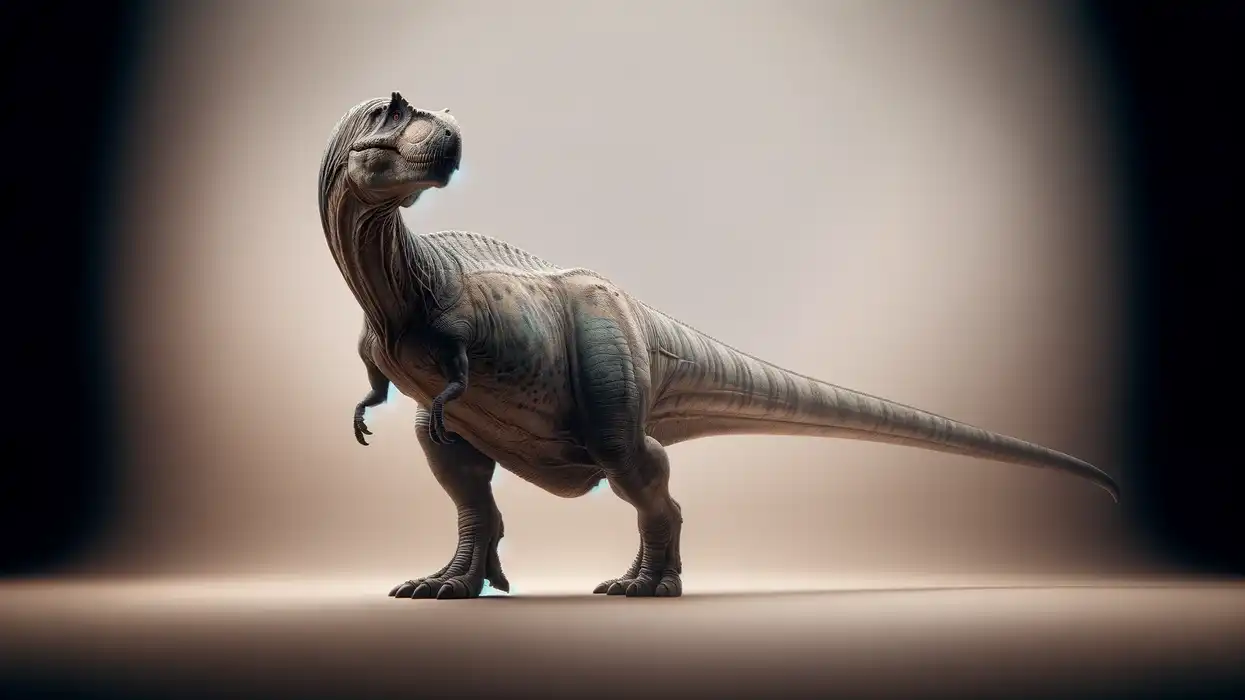The Maiasaura, derived from the Greek words meaning 'good mother lizard', carries a profound significance that extends far beyond its nomenclature, encapsulating the remarkable parenting behaviors exhibited by these Late Cretaceous hadrosaurids approximately 76.7 million years ago.
The essence of their name is rooted in a series of groundbreaking paleontological finds that illuminated the extent of their social and familial interactions which stand as a milestone in dinosaur behavioral studies.
The laborious excavations and meticulous studies carried out by preeminent American paleontologists Robert Makela and his peers have brought to light the extraordinary evidence of large Maiasaura herds. These herds were discovered within the nourishing habitat of the Two Medicine Formation, a treasure trove of paleontological significance located in Montana, USA.
There, scientists unveiled compelling evidence in the form of well-preserved nests, countless broken eggshells, and the remnants of juvenile dinosaurs, which collectively painted a picture of communal living and mutual care not previously associated with dinosaurs.
These findings enabled researchers to infer a high level of parental investment and care, suggesting that adult Maiasaura provided sustained nurturing and protection to their brood, and potentially even shared communal responsibilities within the herd.
The exceptional discovery has greatly enriched the field of vertebrate paleontology, providing substantial insights into the highly-developed social structures that characterized these prehistoric creatures, and challenging prior assumptions of dinosaur life and parenting strategies during the Upper Cretaceous Period (100.5-66 million years ago).
Maiasaura Interesting Facts
How do you pronounce 'Maiasaura'?
Pronounce it as 'MY-uh-SAW-ruh' and marvel at the name that underscores their maternal instincts.
What type of dinosaur are they?
The Maiasaura was a hadrosaurid, characterized by its duck-bill facial structure.
In which geological period did the Maiasaura roam the Earth?
This gentle giant lived in the Late Cretaceous Period, close to 76.7 million years ago.
When did they become extinct?
The Maiasaura shared the fate of other dinosaurs, becoming extinct by the end of the Cretaceous Period (66 million years ago).
Where did the dinosaur live?
The Maiasaura lived in the area now known as Montana, within the rocks of the Two Medicine Formation.
What was a Maiasaura's habitat?
It roamed forests and lived near water sources on floodplains, perfect for a thriving Maiasaura herd.
Who did a Maiasaura live with?
They lived in herds that provided protective environments for numerous juveniles.
How long did a Maiasaura live?
While the exact life span of the Maiasaura is uncertain, a thorough examination of fifty Maiasaura leg bones (tibiae) revealed that these dinosaurs attained sexual maturity around the age of three and reached full skeletal growth by the age of eight.
How did they reproduce?

The Maiasaura reproduced by laying eggs, evident from the so many eggshells found at nesting sites.
Maiasaura Fun Facts
What did the dinosaur look like?

The Maiasaura, notable for their distinct duck-billed snouts and heavy, muscular tails, were well-adapted to support their substantial body weight. Exhibiting the hallmark traits of hadrosaurids, they had a stout frame and a characteristic flat beak, complemented by small horn-like protrusions above their noses.
Their physical structure was further defined by hind limbs that were significantly longer than their front ones, suggesting a bipedal or quadrupedal posture.
How many bones did a Maiasaura have?
A complete skeleton includes hundreds of bones.
How did they communicate?
Communication likely involved sounds and visual displays, though the exact methods are uncertain.
How big were they?
On average, the Maiasaura reached lengths of about 30 ft (9 m).
How fast could this dinosaur move?
These dinosaurs were likely adept at moving at moderate speeds of 25 mph (40.2 kph) to evade predators.
How much did a Maiasaura weigh?

Weighing up to 8,800 lb (4,000 kg), their size played a role in deterring smaller predators.
What were the male and female names of the species?
There is no special distinction; both sexes were referred to as Maiasaura.
What would you call a baby Maiasaura?
A baby Maiasaura is called a 'hatchling' or 'nestling'.
How aggressive were they?
Presumably, not very aggressive due to their herbivorous nature and emphasis on group living for protection.
Did you know...
Evidence from Egg Mountain suggests the Maiasaura may have been the first dinosaur to exhibit profound parental care by feeding hatchlings and creating safe nesting environments. Their nurturing behavior is illuminated by the broken eggshells and so many eggshells found together, indicating a structured, colony-like society where adults took an active role in the welfare of their young.
The Maiasaura herds were thought to be structured in a way that allowed adult dinosaurs to actively participate in the nurturing and defense of their young, showcasing an advanced form of parental care rarely seen in other dinosaur species.
In the Late Cretaceous North America, the Maiasaura thrived in the lush floodplain ecosystems, indicative of their adaptability and the richness of the dinosaur fauna in this region at the time.
American paleontologists, including Robert Makela, were instrumental in the discovery of the Maiasaura, contributing significantly to the understanding of these dinosaurs' social and reproductive behaviors through their work in Montana.
The Maiasaura may have used rotting vegetation within their nests to generate heat, facilitating the incubation process and highlighting their complex nesting behaviors, a strategy indicative of their parental care.
The Maiasaura's diet consisted mainly of vegetation, and it likely included a variety of other plants available in their Late Cretaceous floodplain habitats, providing the necessary nutrition for these large herbivorous dinosaurs.
The Maiasaura holds the distinguished honor of being named the state fossil of Montana, a testament to its significant place in the paleontological history of the region and its contribution to the understanding of dinosaur family life.
While the Maiasaura shared many features with other hadrosaurs, such as their duck-billed snouts, it was their evidence of complex parenting strategies that set them apart, offering deeper insights into the family dynamics of these dinosaurs.
Further investigation into the Maiasaura's nesting grounds provided by paleontologists has shed light on the species' sophisticated social behavior, suggesting a communal approach to raising young unlike any other dinosaur.
The discovery of the Maiasaura nests arranged in a spiral pattern allows paleontologists to infer that these dinosaurs had a colony-like nesting behavior, enhancing the understanding of their complex social systems.
The significant paleontological finds consisted of well-preserved Maiasaura egg clutches, nests, and fossils, enabling scientists to reconstruct their nurturing behaviors and the social structures within their herds.
Reaching an adult size of up to 30 ft (9 m) in length, Maiasaura were large hadrosaurids that used their size and social behavior to protect and care for their young in the predator-filled landscapes of the Late Cretaceous.
Jack Horner, a renowned paleontologist, co-discovered the first Maiasaura nests, which provided unprecedented evidence of dinosaur parenting, altering the perception of these ancient creatures' behavior.
Fossil evidence suggests that the Maiasaura may have returned to the same nesting grounds each year, using sites from the previous year, indicating a remarkable pattern of habitual behavior and site fidelity.
Specimens of the Maiasaura are prominently featured in museums around the world, where they educate the public about the dinosaurs' role as attentive parents during the Cretaceous Period.
The region where the Maiasaura lived provided plenty of resources essential for their sustenance and growth, as evidenced by the abundant plant life documented in the fossil record of the Two Medicine Formation.
The fossilized teeth of the Maiasaura indicate that they had a specialized dentition for consuming tough vegetation, an adaptation essential for their herbivorous diet.
As an herbivorous animal, the Maiasaura played a crucial ecological role, shaping the vegetation landscape of the Late Cretaceous Period through their foraging behaviors.
FAQs

Why is Maiasaura called the 'Good Mother Lizard'?
The Maiasaura earned the moniker 'good mother lizard' due to the significant evidence of communal nesting, brooding, and care for their offspring. Excavations in the Two Medicine Formation revealed clusters of nests, which indicated that the Maiasaura likely returned year after year to the same nesting sites.
The arrangement and structure suggested a social system in which adults possibly guarded and cared for the hatchlings collectively.
Why did they go extinct?
Like all non-avian dinosaurs, the Maiasaura went extinct around 66 million years ago, likely due to the Cretaceous-Paleogene (K-Pg) extinction event. Although the exact cause is debated among scientists, the most widely accepted theory involves a massive asteroid impact that led to drastic environmental changes, disrupting the dinosaurs’ habitats and food sources, ultimately resulting in their extinction.
What was the Maiasaura behavior?
The Maiasaura behavior, as reconstructed from fossil evidence, indicates a highly social creature with complex herd behaviors. Findings suggest these dinosaurs lived in large groups, providing safety for numerous juveniles and possibly facilitating cooperative nesting and defense against predators. The spatial distribution of nests and eggshells at fossil sites indicates organized communal living.
Were the dinosaurs good parents?
Fossil sites rich with Maiasaura eggshells, nests, and young highlighted that the Maiasaura were exemplary parents by the standards of the dinosaur world. These creatures are believed to have built nests for their eggs, protected their young from predators, and likely brought food for their hatchlings, a behavior considered advanced among dinosaurs and indicative of dedicated parental care.
The discovery at Egg Mountain particularly underscores the extent of their parental investment.
How did Maiasaura nourish their young?
Fossil evidence from nesting sites points to the Maiasaura parents possibly bringing food to their hatchlings. The presence of numerous juveniles at different stages of growth suggests that the young may have stayed in the nest for a significant period, requiring parental provisioning.
The chewed plant material found in the vicinity of nests supports the idea that they nourished their young until they were capable of independent feeding.
What can the dinosaur's nesting sites tell about their social structure?
The discovery of the Maiasaura nesting sites, particularly at Egg Mountain in Montana, reveals a highly organized social structure. The nests were spaced evenly apart, indicating a cooperative and possibly communal society.
This arrangement would have enabled better defense against predators and suggests that the Maiasaura may have lived in closely knit herds where communal care for the young was a shared responsibility.
How did Maiasaura defend themselves and their young?
While the Maiasaura were herbivorous and not built for aggression, their size alone was a natural deterrent to some predators. Living in herds offered additional protection; this collective living likely provided safety in numbers, where group vigilance could alert members to the presence of threats.
Additionally, their strong legs could have been used to fend off smaller attackers when necessary.
What does the presence of so many eggshells and broken eggshells at Maiasaura sites signify?
The abundance of eggshells and broken eggshells at the Maiasaura sites signifies that these areas functioned as nesting grounds where generations of the Maiasaura hatched.
This repeated use of the same nesting grounds suggests a pattern of behavior akin to modern birds, exemplifying the cyclical nature of life and the importance of these sites for the survival of the Maiasaura populations.
Moreover, the broken eggshells indicate successful hatching and the nurturing behavior of adults who might have assisted hatchlings in emerging from their eggs.
The Maiasaura paints a vivid picture of dinosaur life in the Late Cretaceous Period. The findings from the Two Medicine Formation have significantly contributed to vertebrate paleontology, offering insights into the evolutionary history of these magnificent creatures.
The Maiasaura's dedication to their offspring showcases a softer side to these ancient giants, living several million years ago, and challenges the understanding of dinosaur behavior and ecosystem dynamics.
Related Articles Around the Web


